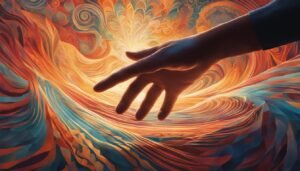Understanding the Symbolism: Decoding the language of dreams
When we close our eyes and drift into the realm of dreams, we often find ourselves in a world filled with symbols and hidden meanings. These symbols can take many forms – objects, animals, colors, or even people – and they serve as the language of our subconscious mind. Decoding this symbolism is the key to unraveling the deeper messages and insights that our dreams are trying to communicate to us. It is through understanding the symbolism in our dreams that we can gain valuable insights into our own emotions, desires, and fears that may be lurking beneath the surface of our conscious awareness. By delving into the language of dreams, we embark on a fascinating journey of self-discovery and exploration.
Common Dream Themes: Exploring recurring symbols and their significance
Recurring symbols in dreams are a fascinating subject that has captivated dream interpreters for centuries. These symbols can offer valuable insights into our subconscious minds and shed light on our deepest desires, fears, and emotions. From common symbols such as water, money, and houses, to more enigmatic symbols like mirrors, snakes, and spiders, each holds a unique significance in the dream realm.
Water, for instance, often represents the ebb and flow of our emotions. Its calmness or turbulence mirrors our internal state, reflecting our feelings of tranquility or upheaval. Money, on the other hand, often symbolizes feelings of abundance, success, or insecurity. The presence of houses in our dreams signifies our sense of self and our living conditions. These recurring symbols, among many others, offer clues to understanding ourselves on a deeper level and can lead to personal growth and self-awareness. As we unravel the symbolism behind our dreams, we gain a richer understanding of our inner world.
Animals in Dreams: Unveiling the hidden messages behind animal encounters
Dreams have long been regarded as windows into our subconscious, providing glimpses into our deepest desires, fears, and emotions. Among the myriad of symbols and themes that appear in dreams, animals hold a special significance. Many cultures and belief systems ascribe specific meanings to animal encounters in dreams, seeing them as messengers or even guides from the spiritual realm. Whether it is a majestic eagle soaring through the sky or a cunning fox lurking in the shadows, the animal that appears in our dreams can offer valuable insight into our waking life.
The interpretation of animals in dreams varies across cultures and individuals, but there are some common themes that emerge. For example, the presence of a snake in a dream often represents transformation or healing, symbolizing the shedding of old skin and embracing new beginnings. Similarly, a wolf might symbolize loyalty, intuition, and a deep connection to our primal instincts. By understanding the qualities and characteristics associated with different animals, we can begin to decipher the hidden messages they may be conveying in our dreams.
Objects and their Meanings: Interpreting the symbolism of everyday objects in dreams
Objects play a significant role in our dreams, often acting as symbols that hold deeper meanings. From a simple everyday item to a complex tool, the objects we encounter in our dreams can convey messages about our emotions, desires, or fears. For example, a mirror in a dream may represent self-reflection or the need to look deeper into oneself. Similarly, a key could symbolize an opportunity or a solution to a problem that needs unlocking. These objects can serve as a window into our subconscious, giving us insights into our innermost thoughts and feelings.
Interpreting the symbolism of objects in dreams requires a careful analysis of the context and personal associations that these objects hold for the dreamer. While some objects may have universal symbolisms, such as a clock representing the passage of time or a door symbolizing opportunities, others may carry more personal significance. For instance, a childhood toy may evoke feelings of nostalgia and reflect the dreamer’s longing for simpler times. By exploring the connections between objects in dreams and their personal meanings, one can gain a better understanding of their subconscious mind and the messages it is trying to convey.
Colors in Dreams: Analyzing the emotional and psychological implications of different colors
Colors play a significant role in our dreams, often carrying emotional and psychological implications that can provide valuable insights into our subconscious thoughts and feelings. The interpretation of colors in dreams can vary depending on personal experiences and cultural background, but there are some common associations that can be explored. For instance, the color red is often associated with passion, anger, and intensity, while blue is connected to calmness, tranquility, and communication. Yellow is often linked to happiness, optimism, and mental clarity, while green is associated with growth, rejuvenation, and balance. Additionally, black is often connected to mystery, power, and fear, while white signifies purity, innocence, and new beginnings. By paying attention to the colors present in our dreams, we can gain a deeper understanding of our emotional state and the messages that our subconscious is trying to convey.
Dreams containing a specific color can evoke strong emotions and trigger certain psychological responses. For example, a dream filled with vibrant shades of red may indicate the presence of intense desires or pent-up anger in the dreamer’s waking life. On the other hand, a dream dominated by soft blues may suggest a need for calmness and open expression of emotions. Understanding the emotional and psychological implications of different colors in dreams can help us uncover underlying conflicts, desires, and emotions that we may not be consciously aware of. By carefully examining the colors present in our dreams, we can gain valuable insights into our innermost thoughts and feelings, and begin to navigate our waking lives with a deeper sense of self-awareness and understanding.
People in Dreams: Unraveling the significance of familiar and unfamiliar faces
In the realm of dreams, the presence of people can hold profound symbolism and meaning. Familiar faces that appear in our dreams often represent aspects of ourselves or individuals we have deep connections with. These dreams may reflect unresolved issues or relationships that need our attention. Seeing the face of a loved one who has passed away can be particularly meaningful, as it may signify messages from the spiritual realm or the need for emotional healing. Conversely, unfamiliar faces in dreams can be seen as representations of unknown aspects of ourselves or the exploration of new potentials. These dreams may symbolize our curiosity, desire for growth, or the emergence of new opportunities in our waking life. It is important to pay attention to the emotions and interactions experienced within these dreams, as they can provide valuable insights into our own desires, fears, and aspirations.
Nature and Landscapes: Delving into the deeper meanings of natural environments in dreams
Dreams have long been interconnected with the natural world, as people often find themselves experiencing natural environments in their dreams. The symbolism behind these dreamscapes can vary greatly, depending on the specific elements present and the emotions evoked. For instance, dreaming about a serene beach might represent a sense of peace and tranquility, while a raging storm could signify inner turmoil or conflict. The natural landscapes encountered in dreams have the power to reflect not only our own inner states but also our connection to the broader world around us. Whether it’s a vast mountain range or a lush forest, the interpretation of these natural environments can provide valuable insights into our subconscious desires, fears, and emotions.
Furthermore, the specific elements within these landscapes hold significance as well. The presence of water, for example, is often associated with emotions and the unconscious mind. Calm and clear water might symbolize a positive emotional state, while choppy or murky water might suggest emotional disturbances. Similarly, the presence of animals in natural landscapes can further enrich the symbolism of dreams. The behavior and characteristics of animals encountered in dreams can shed light on unconscious instincts, desires, or aspects of ourselves that we may be neglecting or suppressing. Exploring the deeper meanings of natural environments in dreams offers a fascinating glimpse into our subconscious selves and helps us better understand our own spiritual and psychological journey.
Dreaming about Death: Addressing the common fears and interpretations surrounding mortality in dreams
Death is a universally feared and mysterious concept that often finds its way into our dreams. When we dream about death, it can evoke a wide range of emotions and interpretations. For some, it may symbolize the fear of losing loved ones or the anxiety surrounding our own mortality. Others may see it as a metaphorical representation of change or transformation in their lives. The meaning behind dreaming about death can vary greatly depending on individual beliefs, experiences, and cultural backgrounds. Whether it is a fleeting image or a recurring theme in our dreams, exploring the common fears and interpretations surrounding mortality can offer valuable insights into our subconscious thoughts and fears.
One common interpretation of dreaming about death is the idea of endings and new beginnings. Death in dreams can represent the end of a phase or a significant aspect of our lives. It may signify the closure of a relationship, a job, or a project, creating space for new opportunities and growth. This interpretation suggests that dreaming about death is not necessarily a negative symbol, but rather a symbol of rebirth and transformation. It encourages us to embrace change and let go of the past to make room for new beginnings and personal growth. However, it is important to remember that dreams are highly subjective, and the meaning of death in a dream can vary depending on the individual’s personal experiences and perspectives.
Flying and Falling: Exploring the metaphorical interpretations of these common dream experiences
Flying and falling are two common experiences that many people encounter in their dreams. These dream scenarios can hold a variety of metaphorical interpretations and are often linked to feelings of freedom and loss of control, respectively. When we dream of flying, it can symbolize a sense of liberation and breaking free from constraints or limitations. This dream experience can represent a desire for independence, exploring new possibilities, or simply a longing for a sense of freedom in our waking lives. On the other hand, dreaming of falling can signify a lack of stability or control in our lives. This dream experience often leaves us with a feeling of vulnerability and powerlessness, reflecting our fears or anxieties of losing control or experiencing failure in real life.
Nightmares vs. Lucid Dreams: Differentiating between distressing dreams and empowering lucid experiences
Nightmares and lucid dreams are intriguing phenomena that occur during our sleep. While both types of dreams can be vivid and intense, they differ significantly in their emotional impact and the level of control the dreamer has over the dream experience.
Nightmares are often characterized by feelings of fear, anxiety, and terror. They can be distressing and leave the dreamer feeling unsettled upon awakening. Nightmares usually involve threatening or dangerous situations, which can evoke strong negative emotions during the dream. The dreamer may feel helpless and unable to alter the course of events, leading to a sense of powerlessness. These distressing dreams can linger in the mind, affecting the dreamer’s mood and emotions long after waking up.
In contrast, lucid dreams offer a contrasting experience of empowerment and awareness. In a lucid dream, the dreamer becomes conscious within the dream and realizes that they are dreaming, allowing them to actively participate and manipulate the dream environment. Lucid dreaming can be an exciting and empowering experience as the dreamer gains control over their actions and decisions within the dream. This increased control can help reduce fear and anxiety, as the dreamer can change the direction of the dream or even wake themselves up if they choose to do so.
Understanding the differences between nightmares and lucid dreams can help individuals navigate and make sense of their dream experiences. By recognizing the patterns and emotions associated with these dreams, dreamers can gain insights into their subconscious fears and unconscious desires. Exploring these dream worlds can unlock a deeper understanding of one’s psyche and provide opportunities for personal growth and healing.
What is the difference between nightmares and lucid dreams?
Nightmares are distressing dreams that evoke fear, anxiety, or other negative emotions, while lucid dreams are dreams in which the dreamer is aware that they are dreaming and can often control the dream.
How can I decode the symbolism in my dreams?
Understanding the symbolism in dreams can be subjective, but by exploring common interpretations and reflecting on personal associations, you can begin to decipher the hidden meanings within your dreams.
What are some common dream themes and their significance?
Common dream themes include falling, flying, being chased, and being naked in public. These themes often symbolize feelings of insecurity, fear, or a desire for freedom and control.
What do animals symbolize in dreams?
Animals in dreams can represent various qualities or emotions. For example, a lion may symbolize courage or power, while a snake could represent transformation or hidden fears.
How can I interpret the symbolism of everyday objects in dreams?
Everyday objects in dreams can hold symbolic meanings. For example, a key might represent access to new opportunities, while a mirror could reflect self-reflection or self-image.
What do different colors in dreams signify?
Colors in dreams can have emotional and psychological implications. For instance, red may symbolize passion or anger, while blue could represent calmness or sadness.
What do familiar and unfamiliar faces in dreams mean?
People in dreams, whether familiar or unfamiliar, often represent aspects of the dreamer’s own personality or emotions. Familiar faces may symbolize known aspects, while unfamiliar faces could represent undiscovered parts of oneself.
Are natural environments in dreams significant?
Yes, natural environments in dreams, such as mountains or forests, can symbolize different emotional states or situations. For example, a calm beach may represent relaxation or peace, while a stormy sea could signify turmoil or uncertainty.
What does it mean to dream about death?
Dreaming about death can have various interpretations, including representing major life changes, the end of a phase or relationship, or fears and anxieties about mortality.
What are the metaphorical interpretations of flying and falling dreams?
Flying dreams often represent a sense of freedom, empowerment, or success, while falling dreams can symbolize a loss of control, insecurity, or fear of failure.



